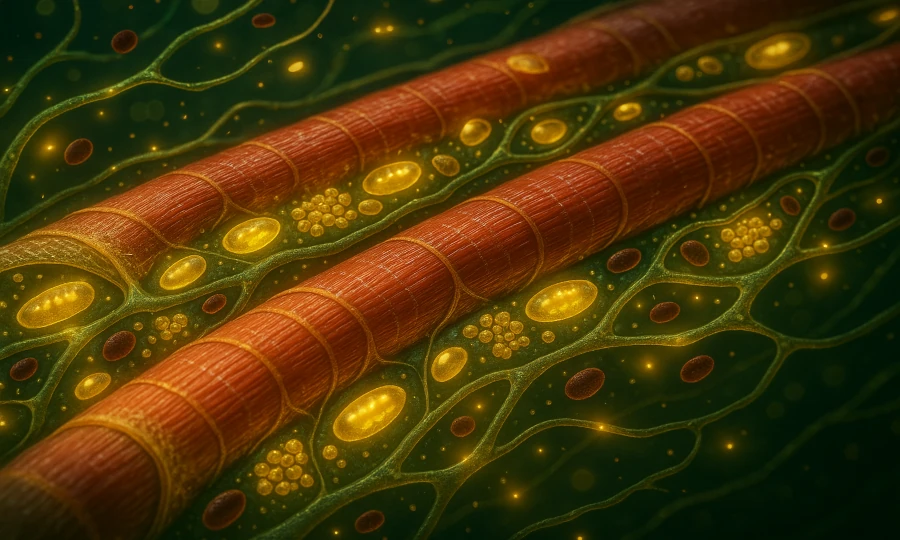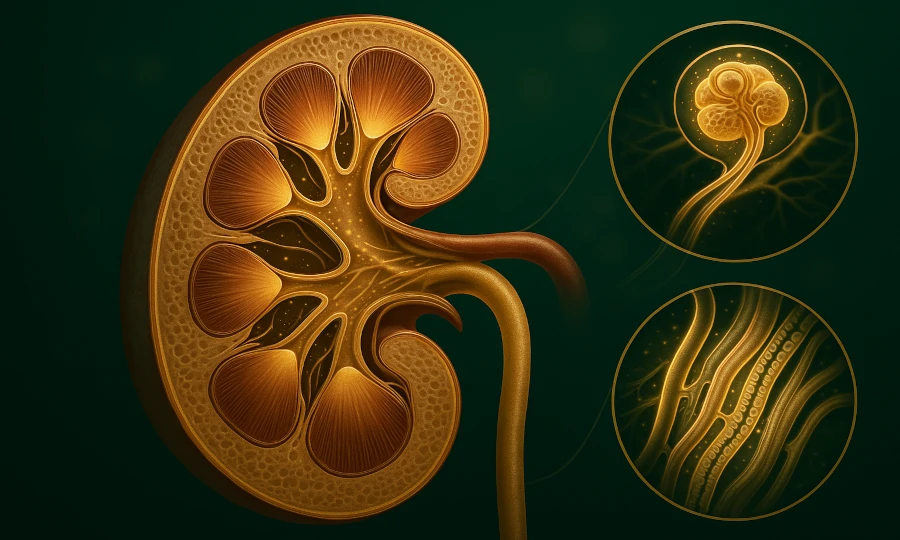
Our musculoskeletal system represents an engineering marvel that enables movement, provides structural support, and protects vital organs. Healthy joints and bones are essential for maintaining mobility, independence, and quality of life throughout all stages of life.
Comprehensive Support for Joint Flexibility and Bone Strength
Roanga Infinity® contains natural bioactive ingredients that can contribute to supporting joint flexibility, comfort, and bone strength. The combination of collagen peptides, plant extracts, and minerals offers a comprehensive approach to musculoskeletal health at various stages of life.
Scientific research suggests that optimal joint and bone health depends on the interplay of several key factors:
- Maintaining the structural integrity of cartilage and connective tissues
- Supporting natural regeneration processes in joints and bones
- Balancing inflammatory responses in joint tissues
- Ensuring optimal bone mineralization and density
Structural Support for Joints and Cartilage
Joints represent complex structures where bones meet, allowing for movement and flexibility. The health of cartilage—the smooth, resilient tissue that covers the ends of bones—is crucial for joint comfort and mobility.
Collagen type II from deer velvet is structurally similar to human joint cartilage and provides building blocks that can support the natural renewal of cartilage tissue. A study published in the Journal of Agricultural and Food Chemistry (2019) suggests that specific peptides derived from collagen can be absorbed and utilized by the body to support connective tissue health (Liu et al., 2019).
Green-lipped mussel extract (Perna canaliculus) contains unique omega-3 fatty acids that can contribute to joint comfort and mobility. Research published in Marine Drugs (2018) documents that bioactive compounds from this New Zealand shellfish can help maintain balanced inflammatory responses in joint tissues (Emelyanov et al., 2018).
These natural substances can help:
- Support the structural integrity of cartilage and connective tissues
- Contribute to joint flexibility and comfort
- Support the natural production of synovial fluid—the "joint lubricant"
- Maintain balanced inflammatory responses in joint tissues
Natural Support for Bone Strength and Density
Bones are living tissues that continuously undergo remodeling—a process where old bone tissue is removed and new bone tissue is formed. This dynamic process requires a balance between bone-forming cells (osteoblasts) and bone-resorbing cells (osteoclasts), as well as adequate supply of minerals and other nutrients.
Calcium and magnesium from natural sources are essential minerals for bone structure. They work synergistically with vitamin D3 and vitamin K2, which help regulate calcium metabolism and direct calcium to bones rather than soft tissues. Scientific research confirms that these nutrients in proper balance are crucial for maintaining bone density and strength (Uwitonze & Razzaque, 2018, Journal of Osteoporosis).
Silica from bamboo extract contributes to collagen formation and mineralization of bone tissue. Studies published in the Journal of Nutrition, Health & Aging suggest that silicon plays an important role in early stages of bone formation and may help maintain bone density (Price et al., 2016).
These natural substances can help:
- Support optimal bone mineralization and density
- Contribute to the structural integrity of bone tissue
- Support balanced bone remodeling processes
- Maintain calcium metabolism and utilization
"Joint and bone health represents a foundation for active living and independence at any age. Natural substances can support these vital structures and help maintain mobility, comfort, and strength throughout life."
Support for Natural Regeneration Processes
The body's ability to repair and regenerate joint and bone tissues is crucial for long-term musculoskeletal health. This capacity naturally decreases with age, making supportive nutrients increasingly important.
Bioactive compounds in deer velvet may support the body's natural regeneration processes. Research published in the Journal of Medicinal Food (2013) suggests that specific peptides in deer velvet can help maintain balanced cellular activity in joint tissues (Wang et al., 2013).
Fucoidan from brown seaweed has been shown to support cellular renewal processes. Studies published in Marine Drugs (2019) document that this unique polysaccharide may help maintain optimal cellular function in connective tissues (Fitton et al., 2019).
These natural substances can help:
- Support the body's natural regeneration processes
- Contribute to tissue renewal in joints and bones
- Maintain balanced cellular activity in musculoskeletal tissues
- Support adaptation to physical stress and activity
Antioxidant Protection for Joint and Bone Tissues
Oxidative stress can affect the health of joint and bone tissues by disrupting cellular processes and contributing to imbalanced inflammatory responses. Natural antioxidants help neutralize free radicals and support cellular health.
OPC (oligomeric proanthocyanidins) from grape seeds are powerful antioxidants that can help protect joint tissues from oxidative stress. Research published in Nutrition Journal (2020) suggests that these plant compounds may help maintain balanced inflammatory responses in connective tissues (Chen et al., 2020).
Lycopene from tomatoes and other plant sources provides antioxidant protection at the cellular level. Studies published in Antioxidants (2019) document that this carotenoid may help maintain cellular health in various tissues, including those of the musculoskeletal system (Mozos et al., 2019).
These natural substances can help:
- Protect joint and bone tissues from oxidative stress
- Support balanced inflammatory responses in connective tissues
- Maintain cellular health in musculoskeletal structures
- Contribute to overall tissue resilience and function
Comprehensive Support for All Age Groups
The need for joint and bone support varies throughout life, with different priorities at different stages:
- For young adults (20-40 years) – supporting active lifestyle, recovery after physical activity, and building bone density reserves
- For middle-aged adults (40-65 years) – maintaining joint flexibility and comfort, supporting bone density during natural age-related changes
- For seniors (65+ years) – preserving mobility and independence, supporting joint comfort, and maintaining bone strength
Roanga Infinity® provides comprehensive support for joint and bone health at any age, with natural bioactive substances that work synergistically to support the body's natural processes.
Frequently Asked Questions
How do joints and bones change with age?
With advancing age, natural changes occur in the musculoskeletal system. After age 30, bone tissue renewal gradually slows down, potentially leading to decreased bone density. Cartilage becomes less elastic and may thin, synovial fluid can change in composition and viscosity, and connective tissues may lose elasticity. These changes can affect mobility, comfort during movement, and overall function of the musculoskeletal system. The good news is that proper nutrition, physical activity, and appropriate dietary supplements can optimally support these natural processes and contribute to maintaining joint and bone health even in older age.
What is the relationship between joint health and physical activity?
Regular, appropriate physical activity is crucial for maintaining joint health. Movement stimulates the production of synovial fluid, which nourishes cartilage and improves joint lubrication. Physical activity also strengthens muscles surrounding joints, providing better support and stability. However, excessive or inappropriate exercise can place undue stress on joints. Finding balance—combining strength training, flexibility exercises, and low-impact activities like swimming or walking—can optimally support joint function while minimizing wear and tear. Natural bioactive substances can complement this approach by supporting the body's regenerative processes and maintaining balanced inflammatory responses in joint tissues.
What is the importance of collagen for musculoskeletal health?
Collagen is the most abundant protein in the human body and forms the basic structural component of bones, cartilage, tendons, ligaments, and other connective tissues. It acts as a "scaffold" that provides tissues with strength, flexibility, and resilience. In bones, collagen makes up approximately 90 % of the organic matter and provides flexibility (while minerals such as calcium and phosphorus provide strength). In joint cartilage, collagen forms a network of fibers that absorbs shock and allows for smooth movement of the joint surfaces. With age, collagen production in the body slows down, which can contribute to changes in the musculoskeletal system. Natural sources of collagen and substances that promote its production can help maintain healthy bone, cartilage, and connective tissue structure.
How can glycosaminoglycans contribute to joint health?
Glycosaminoglycans (GAGs) are complex carbohydrates that form an important component of joint cartilage and synovial fluid. The most important GAGs include chondroitin sulfate, keratan sulfate, and hyaluronic acid. These substances have the ability to bind water, which contributes to the elasticity and resilience of cartilage and the viscosity of synovial fluid, which acts as a "lubricant" in the joints. GAGs also attract and bind nutrients that nourish cartilage. With age, the GAG content in cartilage may decrease, which can affect its function and resilience. Natural sources of GAGs, such as New Zealand green-lipped mussels, can provide the body with these important substances and thus contribute to maintaining joint health.
What is the relationship between oxidative stress and musculoskeletal health?
Oxidative stress occurs when there is an imbalance in the body between the production of free radicals and the body's ability to neutralize them with antioxidants. Free radicals are unstable molecules that can damage cell structures, including DNA, proteins, and membranes. In the context of the musculoskeletal system, oxidative stress can contribute to cartilage degeneration, bone metabolism disruption, and inflammatory processes in the joints. Studies suggest that oxidative stress may play a role in the development of various conditions associated with the musculoskeletal system. Natural antioxidants such as OPC from grapes, lycopene from tomatoes, or fucoidan from seaweed can help neutralize free radicals and thus contribute to the protection of cells and tissues in the musculoskeletal system.
How is inflammation related to joint and bone health?
Inflammation is a natural part of the body's immune response, helping to protect the body from infections and injuries. Short-term (acute) inflammation is usually beneficial and promotes healing. The problem arises when inflammation persists for a long time (chronic inflammation), which can lead to tissue damage. In the context of the musculoskeletal system, chronic inflammation can contribute to cartilage degradation, changes in synovial fluid, and an imbalance between bone tissue breakdown and formation. Certain natural substances, such as omega-3 fatty acids from New Zealand green-lipped mussels or bioactive components of deer velvet, can modulate inflammatory processes and thus contribute to maintaining the natural balance in the tissues of the musculoskeletal system.
Sources and References
- Ayumu Mubuchi, Shoo Katsumoto, Makoto Tsuboi, Hideaki Ishikawa, et al. (2022). Isolation and structural characterization of bioactive glycosaminoglycans from the green-lipped mussel Perna canaliculus. (www.sciencedirect.com/science/article/abs/pii/S0006291X22006374)
- Sarah Geahchan, Parnian Baharlouei, Azizur Rahman, et al. (2022). Marine Collagen: A Promising Biomaterial for Wound Healing, Skin Anti-Aging, and Bone Regeneration. (pmc.ncbi.nlm.nih.gov/articles/PMC8780088/)
- Baojin Yao, Zhenwei Zhou, Mei Zhang, Xiangyang Leng, Daqing Zhao. (2021). Investigating the molecular control of deer antler extract on articular cartilage. (pmc.ncbi.nlm.nih.gov/articles/PMC7788833/)
- Magda Molenda, Joanna Kolmas. (2023). The Role of Zinc in Bone Tissue Health and Regeneration—a Review. (pmc.ncbi.nlm.nih.gov/articles/PMC10620276/)
- Madhavi Gupta, Sanjay Dey, Daphisha Marbaniang, et al. (2019). Grape seed extract: having a potential health benefits. (pmc.ncbi.nlm.nih.gov/articles/PMC7054588/)


